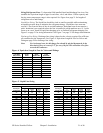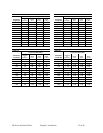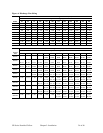
GP Series Portable Chillers Chapter 3: Installation 28 of 90
3-9 Water Reservoir
The standard water reservoir is rotationally molded polyethylene with a removable lid. The
tank is fully insulated to assist maintaining fluid temperature. All portable chillers shipped
during the fall, winter, or spring, or those units that are shipped from stock are flushed at the
factory with a water/ethylene glycol solution to prevent piping components prone to retaining
water from freezing. During startup and when additional solution is required, refer to the
ethylene glycol and propylene glycol curves in Figure 11: Ethylene Glycol and Propylene
Glycol Curves on page 30. Add a pre-mixed solution of industrial quality (not automotive),
inhibited ethylene glycol or propylene glycol and water to provide freeze protection to a
temperature 20ºF (11ºC) below the normal chiller operating temperature set point.
Glycol and/or water, with an inhibitor, should be used to protect the materials (copper, steel,
stainless steel, and bronze) in the system from corrosion. If you intend to use straight water,
we strongly advise a minimum leaving water temperature of 45ºF (7ºC) or contact the service
department.
Warning! Operating the chiller setpoint below 45°F (7°C) without the proper
amount of glycol for freeze protection could result in a damaged
evaporator. ACS Group does not warrant the freeze up of the
evaporator under any circumstances.
The following glycol products are available:
Part Number
Description
A0541358
Ethylene glycol, 5 gallons (18.9 liters)
A0539637
Ethylene glycol, 55 gallons (208.2 liters)
A0542990
Propylene glycol, 5 gallons (18.9 liters)
A0542991
Propylene glycol, 55 gallons (208.2 liters)
Caution! Do not connect make-up water directly to the chilled water reservoir unless you
have an approved automatic water make-up system installed.
Caution! Do not pressurize tank. Supply and return connections must be trapped and
vented to allow vertical risers to drain into tank. Do not overfill system. Allow
enough free space in tank for vertical piping to drain.
If your application has chilled water or process piping above the chiller, trap and vent the
supply and return lines to allow vertical piping to drain into tank.
Note: In applications where the process or process piping is above the reservoir, take
steps to prevent over pressurization of the reservoir. This condition can occur
on system shutdown when the water in the system drains into the reservoir. To
prevent this, a vacuum breaker should be installed at the high point of the “To
Process” and “From Process” lines.


















